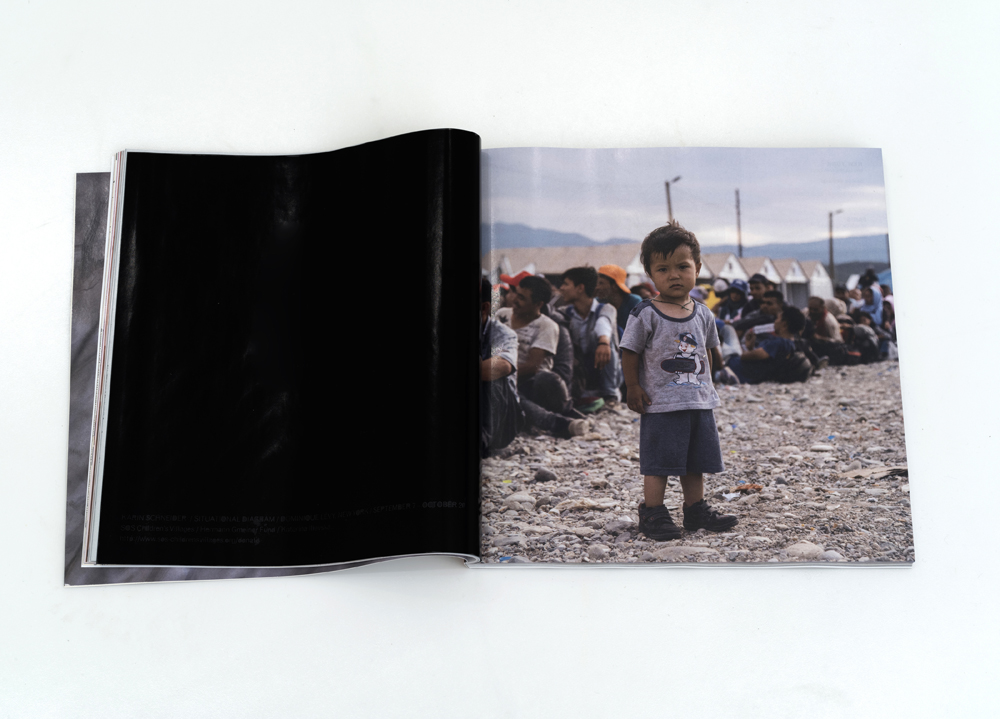Writing for Bomb, critic Wendy Vogel hits on something that too often goes ignored: the hypocritical but well-intentioned pseudo-Marxist political peacocking in a Upper East Side blue-chip gallery space that somehow manages to evade cognitive dissonance. Vogel focuses on Karin Schneider’s solo exhibition at the Swiss dealer Dominique Lévy’s UES space. (To give you some context, this is the same dealer who said that she “can’t sell art in flat shoes.”) Check out Vogel in partial below, the full piece via Bomb.
Collaboration is another facet of the exhibition, which opens on the gallery’s second floor with a one-minute black-and-white 16mm film projection of the Adriatic Sea’s horizon line, framed by a simple wall drawing. A steel-gridded apparatus occupies the other half of the floor, to which is affixed 16 black monochromes from the “Obstructional” series. Each features a 16-by-16-inch square on a 30-by-30-inch canvas. Schneider uses different combinations on each of Mars Black pigment mixed with one of four additional colors: Cobalt Blue, Cadmium Yellow, Cadmium Red, or Phthalo Emerald. Viewing these paintings requires intense perceptual focus. Under the shifting daylight, the borders of Schneider’s squares (painted with varying crispness) blur and fade, forming a poetic rhyme with the Adriatic’s horizon line on film. The “Obstructional” paintings have a conceptual twist, however. As the guide makes clear, the panels, sold separately, will be subject at a future date to an unspecified “alteration” by another (unnamed) artist. In the setting of a blue-chip gallery show, Schneider disavows her painterly gesture, and asks her potential patrons to support a future collaboration—albeit a polite one, exercised within the bounds of a petite canvas.
Another angle of the show considers historical occlusions. Both floors feature “Extraction” sculptures, placed on the ground, of figures excised from famous modernist artworks. In the neoprene sculpture E(HM/NB III-I), two figures are fused together from Henri Matisse’s “Blue Nudes” cutouts (1953). The extraction E (TA/AP) reproduces in steel the man from Brazilian artist Tarsila do Amaral’s oil painting Abaporu (1928). Do Amaral, one of the founders of Brazil’s Anthropofagia movement linking Brazil’s colonialist heritage with cultural cannibalism, is also represented by a version of her painting in an Ad Reinhardt black palette, AR(BP)+TA(AP) (Cancellation). Schneider’s consideration of Do Amaral’s work literally against Reinhardt’s is original, but in reducing both to shadows, Schneider suggests an annulment of radical possibility.
Schneider adds questions of political visibility to her inquiry, with additional canvases in homage to Rothko and Newman created from oil and coal, and black-on-black pictures sporting the country names of Poland, Syria and Serbia. A “digital extraction,” in the puzzling form of a print Artforum ad for the show, includes the link to a refugee nonprofit organization on a black page, opposite a news agency photo of a refugee, circling back to the Adriatic.
Even with (or maybe because of) its political correctness, there’s something a little too neat about Schneider’s outsider-insider status. While at the gallery, I observed Schneider herself guiding a well-known curator in tight circles around the space, a gallery director walking the space separately with a better-known critic than me, and a well-heeled couple (collectors?) whispering in the corner with another gallery representative. This rehearsed and hierarchical choreography suggested nothing of Schneider’s anti-authorship stance. Despite the work’s provocations about historical and contemporary blind spots, the creation of black paintings, in 2016, signifies nothing so much as good taste. It divides the connoisseurs from the ignorant. Ultimately, it provokes a question: Is painting today just a quotation of historically radical ideas, or can it still transmit them?
*Image of Karin Schneider Artforum advertisement via Bomb
